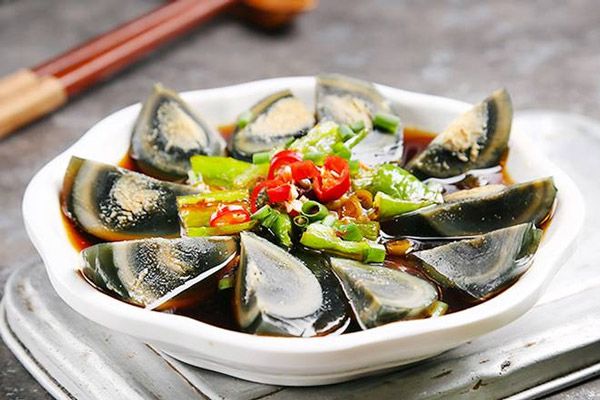
24 Sep Century Eggs & Tiger Skin Peppers: A Superb Sichuan Pairing
Have you ever gone to an authentic Chinese food market? If yes, you’ve likely seen “century eggs.” Also known as “hundred-year-old” or “thousand-year old” eggs, some describe their appearance as akin to dinosaur eggs.
Covered in clay and rice hulls, many mistakenly think the eggs are dug up from the ground. Once peeled, things don’t become any more familiar to those accustomed to normal boiled eggs.
The “white” of a century egg looks translucent with a soy sauce-colored tint. Additionally, the yolk itself is green and black with a texture much like that of a hard-boiled egg.
View this post on Instagram
What are Tiger Skin Peppers
Tiger skin peppers or “hu pi jian jiao” are named for their distinctive striped-looking appearance. The black stripes on the long green peppers come from the process of searing them in a hot wok.
Z & Y Restaurant uses the classic jalapeno pepper for our variation. Originating from the Veracruz region of Mexico, jalapenos are hot, but not overwhelming hot for most eaters.
The balance of the savory century egg with the mild kick of spice and heat from the tiger-skin jalapeno pepper makes for a delicious pairing. Try this one of a kind combination with your next order from Z & Y Restaurant!
View this post on Instagram
The Preparation of Century Eggs
Before getting into the flavor of century eggs, it may help to understand the preparation process. After all, it is this process that gives the eggs their distinctive look.
The Takeout.com describes two common methods of preparing century eggs. One is more traditional and the other is more modern:
“The eggs are coated in a mixture of quicklime and wood ash, along with other alkaline ingredients, and left to “cook” for up to a couple of months, but certainly not a hundred or a thousand years, despite its name. Some producers eschew this traditional process and instead soak the eggs in a sodium hydroxide solution for a month or so.”
So despite what the name implies, it doesn’t actually take 100 years to prepare a century egg.
The Flavor of Century Eggs
The initial bite of a century egg might be a bit unsettling at first. Many experience a slight taste of sulfur or ammonia.
However as China Sichuan Food describes, the experience improves dramatically as the taste buds adjust:
“After the first taste, you will enjoy a world of highly flavorful and umami components which is denatured from egg proteins under the stress of higher PH value.”
Pairings and Presentation Options
There are many different ways to serve a century egg. Chinese restaurants will often serve the dish as an appetizer, sliced into wedges with shavings of pickled ginger.
Hong Kong restaurants often toss century eggs with peanuts, chilis, and Sichuan peppercorn in a Kung Pao style. At Thai dim sum parlors, you may find century eggs cooked into pastries with sweet red bean paste and pickled ginger.
At Z & Y Restaurant, we pair century eggs with another Sichuan specialty, tiger-skin peppers.
View this post on Instagram
What are Tiger Skin Peppers
Tiger skin peppers or “hu pi jian jiao” are named for their distinctive striped-looking appearance. The black stripes on the long green peppers come from the process of searing them in a hot wok.
Z & Y Restaurant uses the classic jalapeno pepper for our variation. Originating from the Veracruz region of Mexico, jalapenos are hot, but not overwhelming hot for most eaters.
The balance of the savory century egg with the mild kick of spice and heat from the tiger-skin jalapeno pepper makes for a delicious pairing. Try this one of a kind combination with your next order from Z & Y Restaurant!







